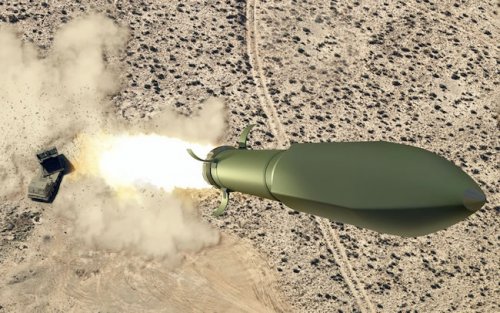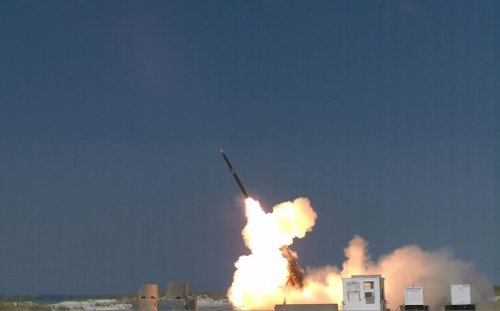Boeing To Demonstrate Ground-Launched SDB System Later This Year
Posted: Feb. 20, 2014
Boeing is attempting to bring an Air Force solution to an Army problem by developing a ground-launched version of the Small Diameter Bomb it produces for the service's F-15 fighter aircraft, and the company will self-fund a test flight of that system later this year. By financing the demonstration, the company hopes the Army will see its Ground-Launched Small Diameter Bomb (GL-SDB) system as a viable replacement munition for the M270 Multiple-Launch Rocket System (MLRS), which currently employs a type of cluster munition being phased out by the Pentagon. In a Jan. 27 interview with Inside the Air Force, Jon Milner, Boeing's GL-SDB business development lead, said the SDB is currently employed on the Air Force's F-15 Strike Eagle as a 250-pound-class, air-to-ground munition, and it happens to also fit easily into the 200-pound-class MLRS launch pods. He said by coupling SDBs with the Army's stockpile of MLRS unguided M26 rocket motors, the bombs can be launched to great altitudes and glide to their targets rather than follow the normal point-to-point ballistic trajectory.
"The GL-SDB is an integration program, not a development from scratch," Milner said. "We've got in-production SDB mature technology, a combat-proven rocket motor and a combat-proven warhead. We're creating the adapter in between them, which we have confidence in." Milner said the company ground-tested the system last December and plans to complete the first flight test sometime in the third quarter of this year. Lockheed Martin is the prime system and munitions contractor for MLRS and is already ahead of Boeing in its development of a replacement munition. The company secured a $79.4 million contract with the Army in 2013 to develop and demonstrate a warhead to replace the current cluster munition, the dual-purpose improved conventional munition (DPICM). The Defense Department is planning to replace the legacy explosive in accordance with its policy on cluster munitions. This policy seeks to phase out all munitions with an unexploded ordnance rate higher than 1 percent by 2018, according to the text of a 2008 directive. In a Feb. 3 press release, Lockheed announced that it had successfully conducted its second production qualification test on its alternative warhead, which is a unitary submunition within the company's M30 guided rocket system.
Boeing's GL-SDB system is unconventional and is substantially different from the one being demonstrated by Lockheed, in that the warhead is guided instead of the rocket motor. "When you shoot a high angle you lose range, because of the higher quadrant," Milner said. "I can launch [GL-SDB] from any location, 360 degrees, because it's [global positioning system]-guided. Once the M26 rocket boosts it to altitude, the SDB acts like it was just released from an F-15 and it glides to wherever it's programmed to hit. It can go around the back side of mountains." Since 2005, Boeing has delivered more than 10,000 SDBs to the Air Force, and according to Milner the Army has more than 400,000 M26 rocket motors in its inventory which would otherwise be demilitarized. Boeing began investigating the system in 2010 in response to requests by engineers at the Army's Redstone Arsenal in Alabama who were looking for new uses for the Army's stockpile of M26 units, according to Milner. "The Small Diameter Bomb just happens to have roughly the same form factor, and if you stick it on top [of the M26] it still fits in the [MLRS] launch-pod container," Milner said. "It's an air-to-ground weapon we're trying to adapt for a ground-to-ground mission."
Boeing has taken its GL-SDB concept to the Pentagon and the Army, but neither is showing much interest in funding further development work -- which is why the company is internally funding its own testing. "In my opinion, what we're offering would be very appealing to the Army," Milne said. "From a budget standpoint, our projected cost would be almost 30 to 40 percent less than the current cost of [Lockheed's] guided MLRS. And if you cut us into the inventory, I think you'd have a cost savings. Depending on how the Army views its budget reality, we could be a very appealing system to them." The company is also eying international customers, but Milner would not say which ones. The MLRS is employed by a number U.S. allies. "It's a way to upgrade your MLRS inventory, achieve longer range, with more capability, for what we project to be a lower cost than buying a new guided MLRS munition which Lockheed Martin sells," Milner said. Any adoption of the GL-SBD system could shore up production of the Small Diameter Bomb well past the U.S. Air Force's current total force requirement of 24,000 units.
Once developed, the GL-SDB is expected to have a range of about 90 miles when launched to the optimal altitude of 40,000 feet. Once the main work of creating the M26 interstage adapter is complete, various types of SDBs can be employed including laser-guided and focused-lethality variants. Boeing's GL-SDB system is also part of an Army analysis of alternatives for the MLRS Army Tactical Missile System (ATACMS) -- a 500-pound-class, long-range, precision munition. Production of the ATACMS ceased in 2007, and that capability gap has so far been filled by air support. "They're re-looking at that because the Air Force doesn't have the aircraft to cover all those missions," Milner said. Separate from Boeing's SDB efforts, Raytheon is also currently developing a laser-guided, seeker-type SDB for the Air Force, known as the Small Diameter Bomb II, which will eventually replace Boeing's weapon. The company announced a successful flight test of that weapon system in October 2013. Although the F-15 is currently the only aircraft which employs the SDB (GBU-39B), the Air Force is planning integration work for the F-16, B-1, B-2, F-22 and F-35, according to the service's fact sheet. -- James Drew





